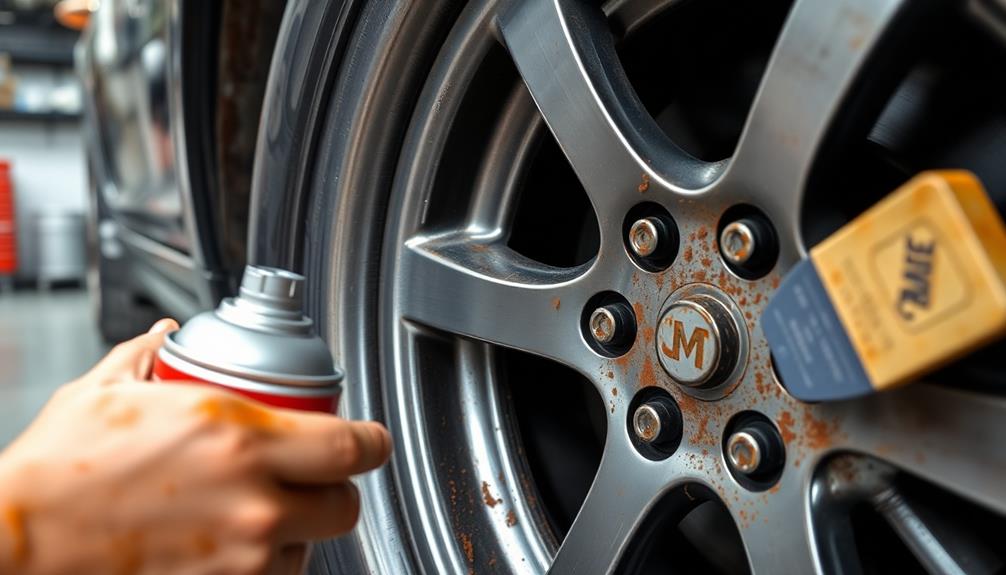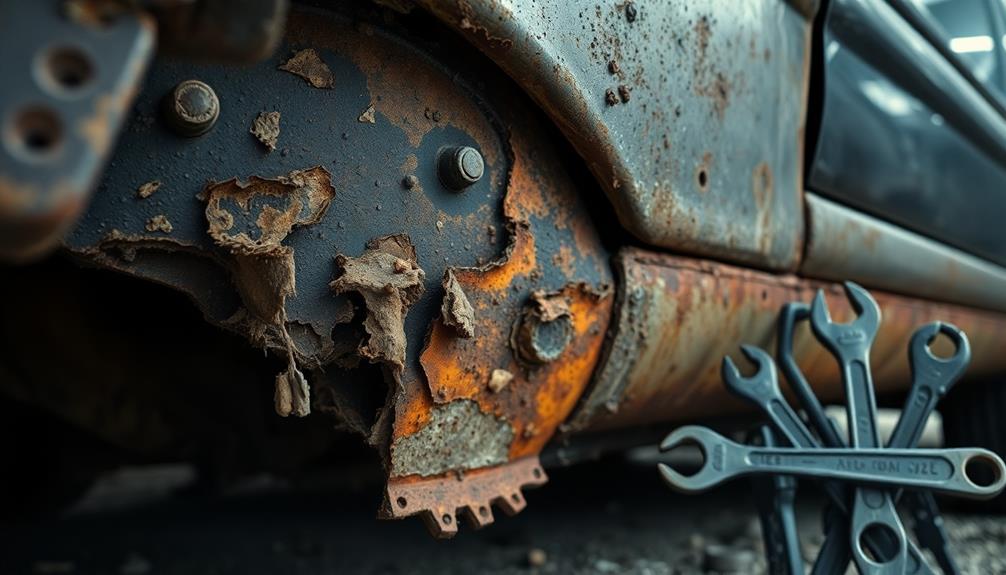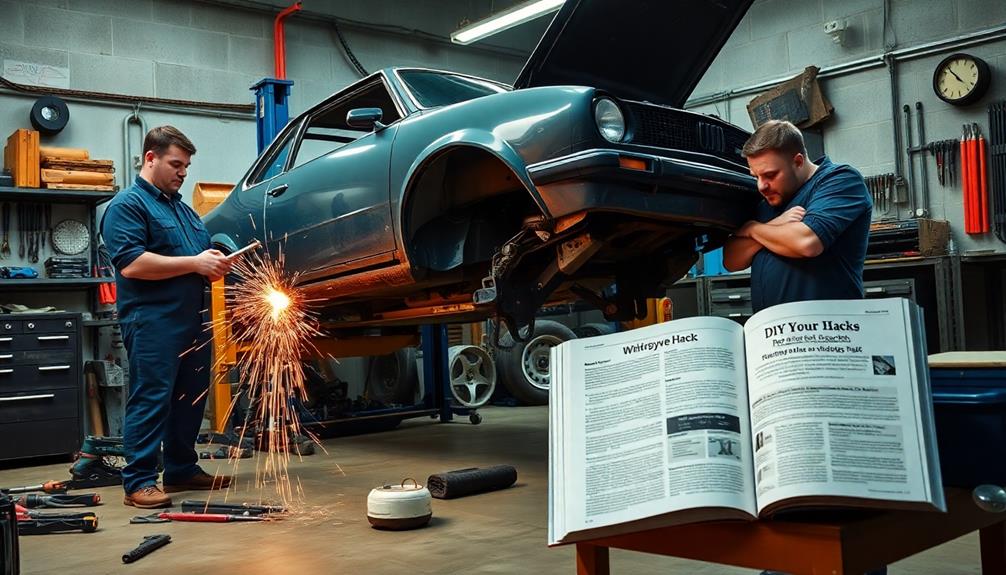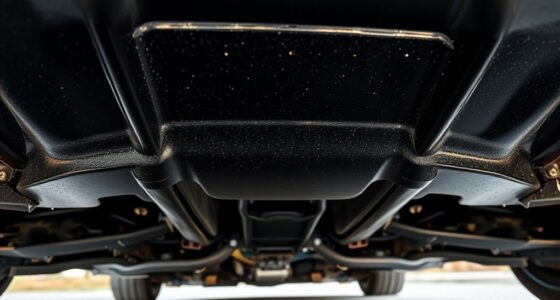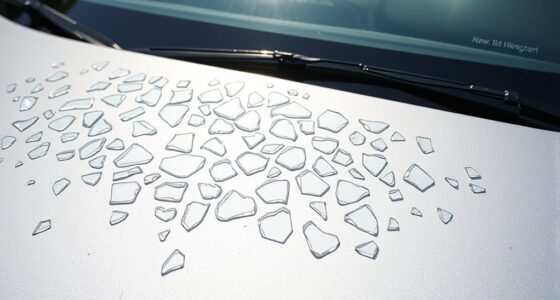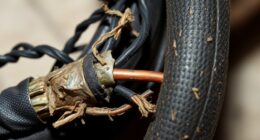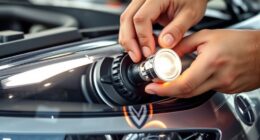You can rust proof your car for just $10 with a simple trick that involves using Fluid Film Anti-Rust Spray. This easy-to-apply coating effectively protects your vehicle from corrosion, especially important in salty environments. Before applying, make sure to thoroughly clean the underbody to remove dirt and salt. Once it's dry, spray the Fluid Film in key areas like the undercarriage and wheel wells. With this method, you can considerably extend your car's lifespan and save on costly repairs. Want to discover more tips and techniques to keep your car rust-free? Keep going!
Key Takeaways
- Use Fluid Film Anti-Rust Spray, which costs around $10, for effective rust protection with a long-lasting coating.
- Apply DIY Oil Application using inexpensive oil products for temporary rust defense lasting 1-2 months.
- Thoroughly clean your vehicle's underbody before application to ensure proper adhesion of the rust-inhibiting coating.
- Focus on key areas like rocker panels and wheel wells to maximize rust protection effectiveness.
- Reapply treatments every 14 months, especially in salt-heavy climates, to maintain robust protection against rust.
Importance of Rust Proofing
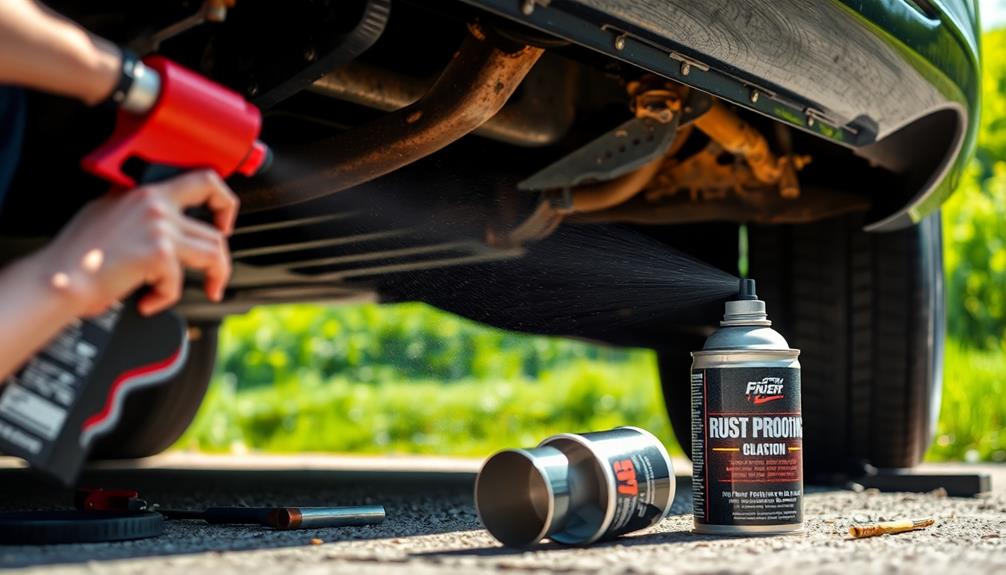
Rust proofing your car is crucial for its longevity and overall performance. If you live in regions where road salt is heavily used, like Ottawa, you know how this substance can wreak havoc on your vehicle. With an annual usage of 180,000 tons of road salt, the risk of rust increases considerably, making rust protection a priority.
There are two main types of rust: surface rust, which affects appearance, and structural rust, which can compromise safety and performance. You mightn't realize that ignoring rust proofing can lead to costly repairs down the line.
By utilizing effective oil spray or wax-based rust inhibitors, such as Krown, you can greatly extend your vehicle's lifespan, especially in harsh winter conditions.
Regular rust proofing not only protects critical components from corrosion but also enhances your car's resale value. Investing in rust protection now means you'll save money and guarantee your vehicle stays in top shape for years to come.
Don't wait until it's too late—prioritize rust proofing to keep your ride safe and sound.
Essential Supplies Needed
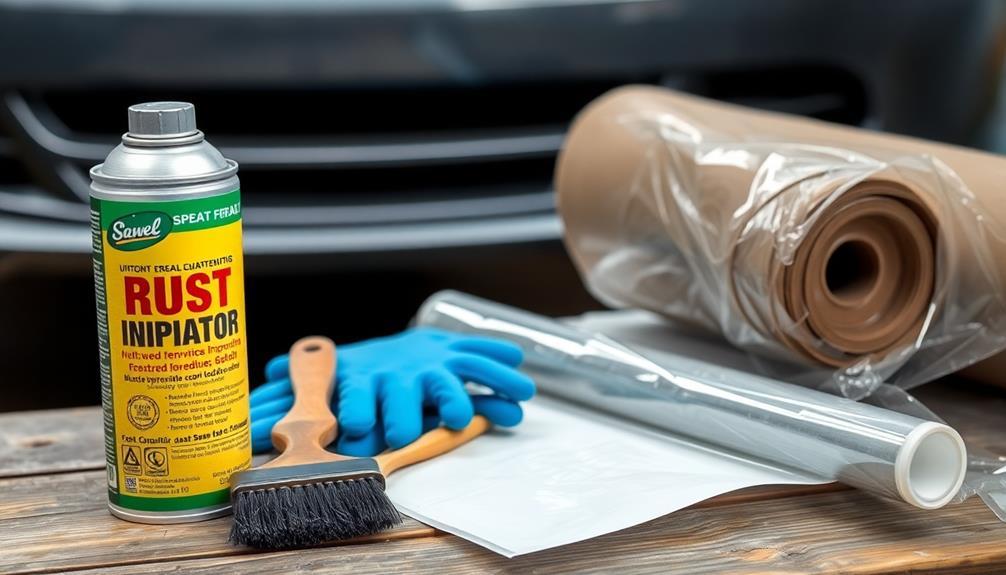
To rust proof your car effectively, you'll need specific tools and supplies.
Start by gathering a rust-inhibiting coating, an applicator spray gun, and essential safety gear like gloves and a respirator.
Having these items on hand guarantees you can tackle the job safely and efficiently.
Necessary Tools and Equipment
When preparing to rust proof your car at home, having the right tools and equipment is fundamental for achieving the best results.
You'll need an oil/wax applicator spray gun with cavity wands to apply the rust-inhibiting coating effectively. This coating can be oil or wax, and you can find it for around $10.
Start by cleaning your car's underbody with a carwash product, then use a degreaser to remove any old coatings. Safety is essential, so wear gloves and a respirator. A tarp can help catch any overspray during the process.
An air compressor with an air hose and a moisture separator is critical for applying the rust-proofing solution. This setup guarantees proper spray pressure and minimizes moisture contamination, which could harm the application.
Before application, prepare rust-prone areas using regular maintenance tools. An angle grinder with a cup wire wheel and a drill with a wire wheel will help you get the surface ready.
Rust Inhibiting Coatings Options
Choosing the right rust-inhibiting coating is essential for protecting your vehicle from corrosion. You'll want to use a high-quality oil or wax that can effectively shield metal surfaces, especially if your car faces harsh winter conditions and road salt.
One of the best ways to apply these rust inhibiting coatings is with an oil/wax applicator spray gun equipped with cavity wands. This tool allows you to target hard-to-reach areas, ensuring complete coverage.
Before you start, gather a few essential supplies. Clean the underbody of your vehicle using a carwash and degreaser to remove any grime that could interfere with the coating.
An air compressor with a pressure regulator and moisture separator will help maintain consistent spray pressure during application. If you want to reach certain areas better, consider drilling holes in specific spots, but do this cautiously.
Lastly, using a tarp can protect your surroundings from overspray, making cleanup easier.
With the right supplies and preparation, you'll be well on your way to rust-proofing your car effectively and affordably.
Safety Gear Requirements
Your safety gear is just as essential as the rust-proofing materials you'll be using. Before starting the application process, make sure you've got the right equipment to protect yourself.
First, wear gloves to guard your skin from harmful chemicals. A respirator is critical, too, to avoid inhaling any toxic fumes while you work. Don't forget goggles to shield your eyes from any potential splashes or debris.
To keep your work area clean, lay down a tarp to catch any overspray or drips. This makes cleanup much easier and prevents contamination of your surroundings.
An oil/wax applicator spray gun with cavity wands is key for applying the rust-proofing material effectively, especially in those hard-to-reach spots.
An air compressor with a pressure regulator and moisture separator will help maintain consistent spray pressure, which is crucial for achieving a uniform coating.
Finally, using a degreaser before you start is a smart move, as it removes any grease or contaminants, ensuring that the rust-proofing material adheres properly.
With the right safety gear and supplies, you'll be well-prepared for your rust-proofing project.
Preparation Steps
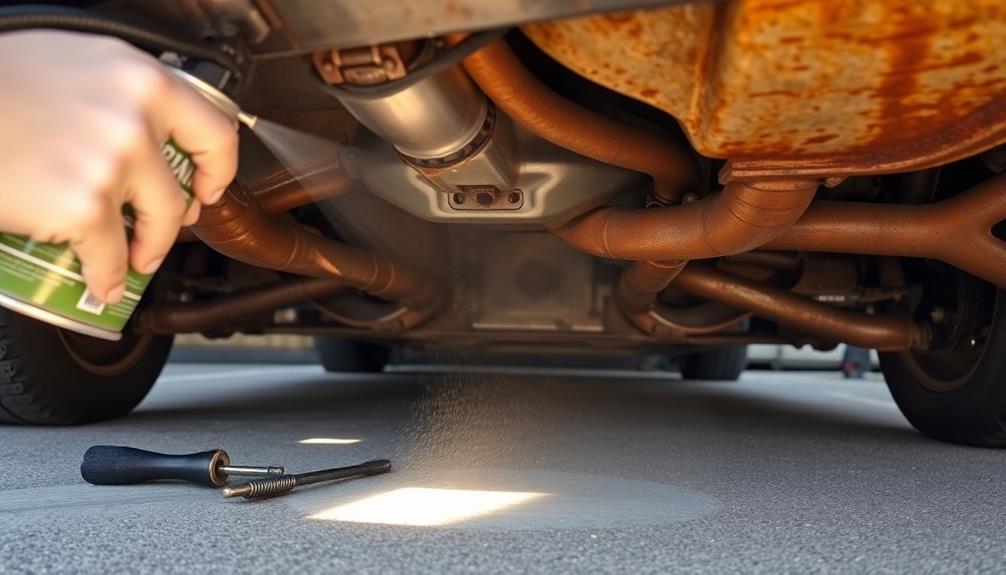
Proper preparation is vital for effective rust proofing, and it begins with a thorough underbody wash of your vehicle. Start by using heated water and a multi-purpose cleaner to tackle dirt, previous coatings, and contaminants that could interfere with the adhesion of the rust-inhibiting coating. This step is essential, as a clean surface guarantees better results.
After washing, let your vehicle dry completely. Moisture can prevent the rust-inhibiting coating from adhering properly, compromising its effectiveness.
Once dry, inspect your vehicle for any existing rust damage. If you find larger areas of rust, use an angle grinder with a cup wire wheel to remove it, then degrease the area to maintain a clean surface for application.
Next, gather all necessary supplies including your rust-inhibiting coating, an oil/wax applicator spray gun with cavity wands, and safety gear like gloves and a respirator. This guarantees you're ready for an effective and safe rust-proofing process.
Cleaning the Underbody
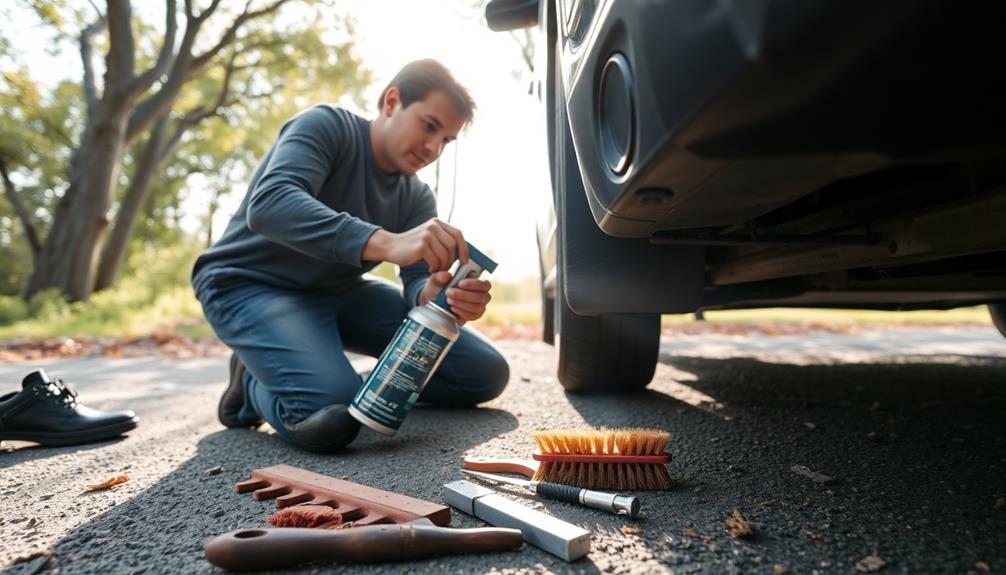
Before you begin the rust-proofing process, cleaning the underbody of your vehicle is vital. A thorough wash removes dirt, salt, and any remnants of previous rust-proofing coatings that could obstruct your new application.
Head to a carwash that offers heated water; this can greatly enhance your cleaning efficiency, especially for built-up grime and contaminants.
To effectively break down stubborn debris, use a multi-purpose cleaner. This guarantees you leave no residue that might compromise the adhesion of your rust-proofing materials.
While you're cleaning, take the time to inspect for any existing rust. Identifying these areas early allows you to apply additional treatments as needed.
Once you've finished washing, let the underbody dry completely. Moisture can interfere with rust-inhibiting coatings, so this step is essential.
By confirming your underbody is clean and dry, you set the stage for a successful rust-proofing application that can protect your vehicle for years to come.
Regularly maintaining this cleaning routine will help keep your car in top shape and minimize future rust issues.
Application Techniques
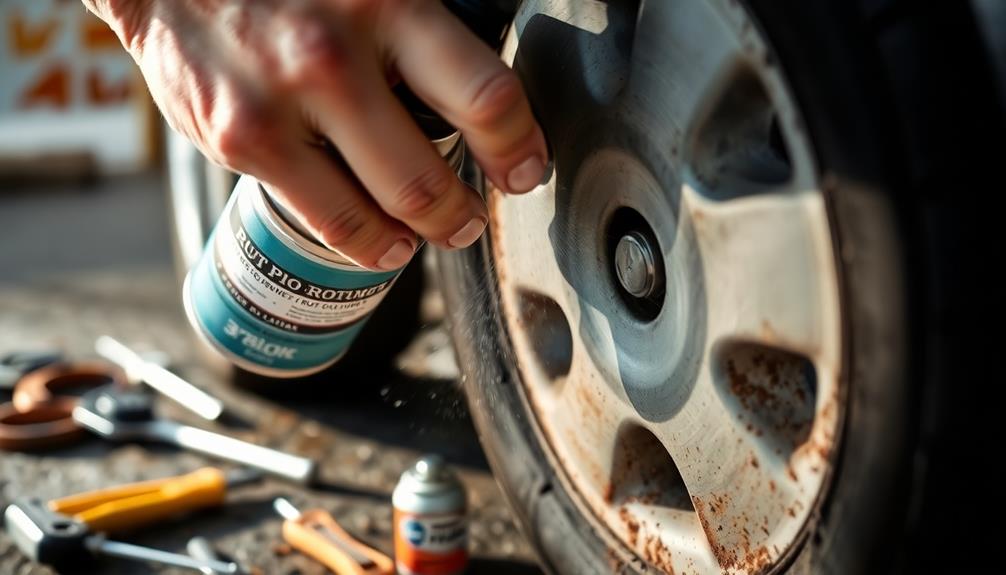
One key to effective rust-proofing is mastering the application techniques that guarantee thorough coverage. Start by using heated water and a degreaser to clean your vehicle's underbody thoroughly, making certain the rust-inhibiting coating adheres properly.
Once clean, grab an oil/wax applicator spray gun with cavity wands. This tool lets you target hard-to-reach areas, like rocker panels and door edges, where rust starts most often.
Utilize drilled access holes in your vehicle's structure to allow the spray to enter confined spaces. This makes sure the rust inhibitor reaches double-walled areas, which are notoriously tricky to protect.
As you spray, remember to work from multiple directions. This technique maximizes coverage and makes sure seams and crevices are thoroughly protected.
After application, it's vital to let the coating set. Avoid driving or exposing your vehicle to water for at least four hours. This waiting period allows the protective layer to bond effectively, giving you the best defense against rust.
Key Areas to Target
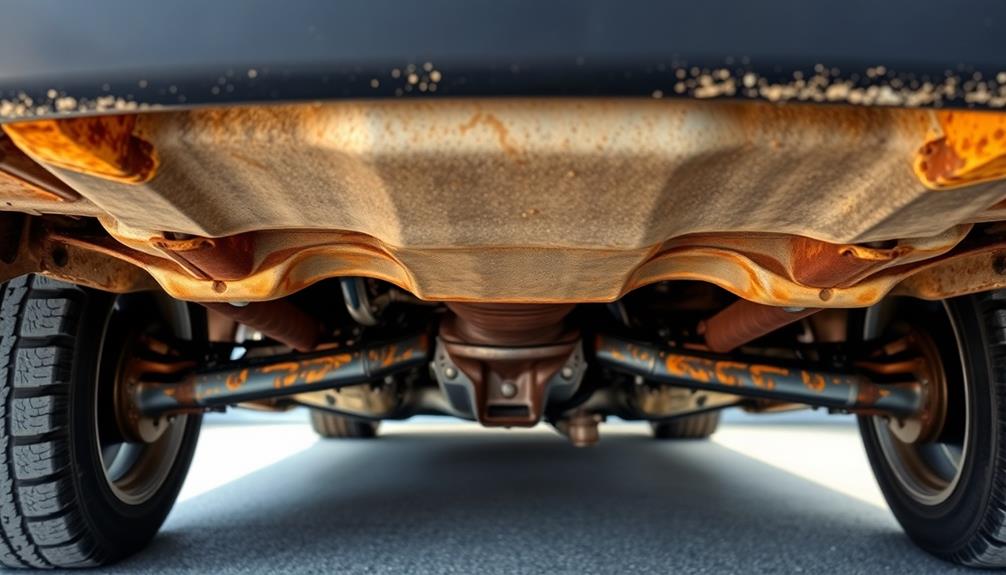
Rust's most common hiding spots can spell trouble for your car if left unprotected. To effectively rust proof your vehicle, focus on key areas that are particularly vulnerable.
Start with the undercarriage, specifically the rocker panels and wheel wells. These locations often collect road debris and moisture, making them prime candidates for rust development.
Pay close attention to seams and joints where metal parts meet, as water and debris can easily become trapped here. Don't overlook the fender openings and door edges; these areas are critical for maintaining your car's integrity and are often neglected during rust proofing efforts.
Utilize access holes in the vehicle's structure to spray rust-inhibiting solutions into hidden spots, ensuring you cover every crevice.
Additionally, inspect and clean out drain holes in the trunk and other compartments. Clogged drains can lead to water accumulation, considerably increasing the risk of rust.
By targeting these key areas, you'll considerably enhance your car's defense against rust and prolong its lifespan.
Don't wait—take action now to keep your vehicle in top shape!
Maintenance and Reapplication
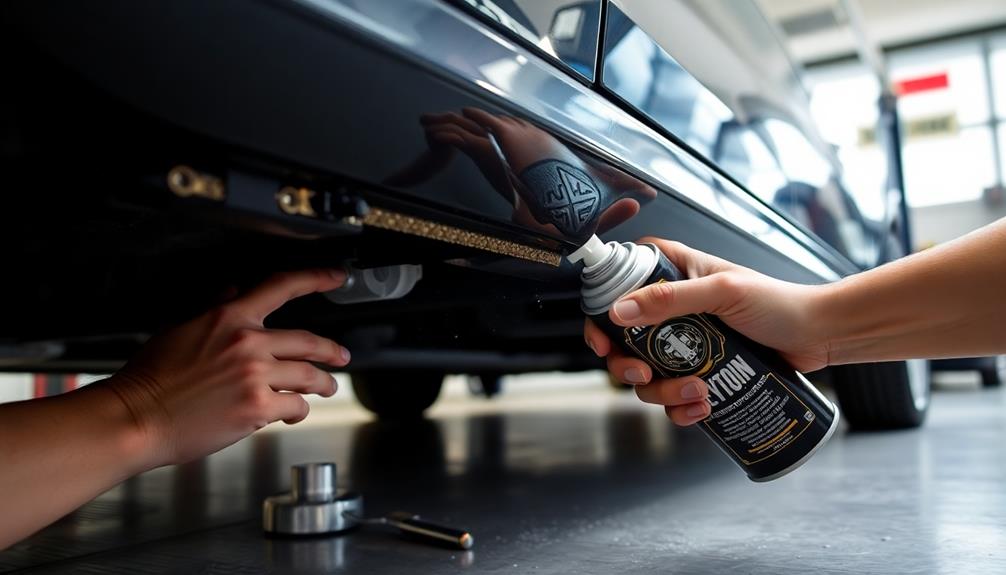
To keep your car protected against rust, regular maintenance and reapplication of rust-proofing treatments are necessary. Typically, you should reapply every 14 months, especially if you live in salt-heavy environments like Ottawa, which uses 180,000 tons of road salt annually.
For a cost-effective DIY solution, consider using products like Krown or Fluid Film, which generally cost around $120 for cars and $140 for larger vehicles.
After applying rust inhibitors, make sure you avoid exposing your vehicle to water for at least 4 hours. This wait time allows the coating to set properly, maximizing its effectiveness against rust.
Regularly inspect your car for any new rust spots or areas that might need touch-ups. These periodic checks are crucial for maintaining the integrity of your rust-proofing treatment and can greatly extend your vehicle's lifespan.
Keep in mind that the frequency of reapplication may vary based on your vehicle's usage, environmental exposure, and the thickness of the initial coating. If you're in a harsher climate, more frequent applications are recommended to keep that rust at bay.
Stay proactive, and your car will thank you!
Cost-Effective Options
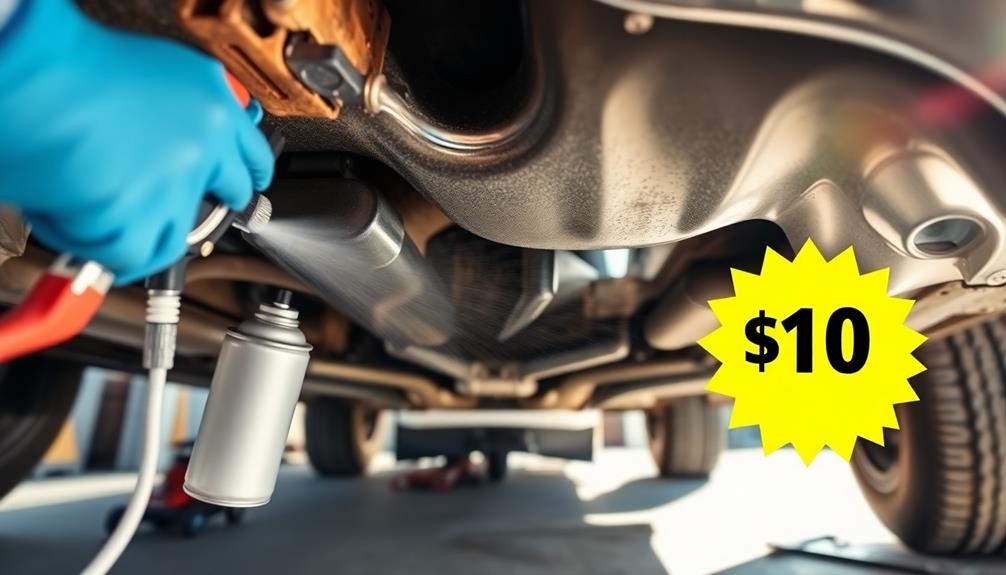
Finding cost-effective options for rust proofing your car can save you money and extend its lifespan. With just $10, you can use products like Fluid Film Anti-Rust Spray to protect your vehicle from corrosion. DIY rust proofing methods are not only budget-friendly but also incredibly effective.
Here's a breakdown of some cost-effective options:
| Method | Cost (Approx.) | Duration of Protection |
|---|---|---|
| Fluid Film Spray | $10 | Up to 14 months |
| Drip Oil Spray | $30 | 1-3 cans needed |
| Wax Spray | $15 | 6-12 months |
| DIY Oil Application | $5 | 1-2 months |
| Professional Service | $120-$150 | 1-2 years |
Final Tips for Success
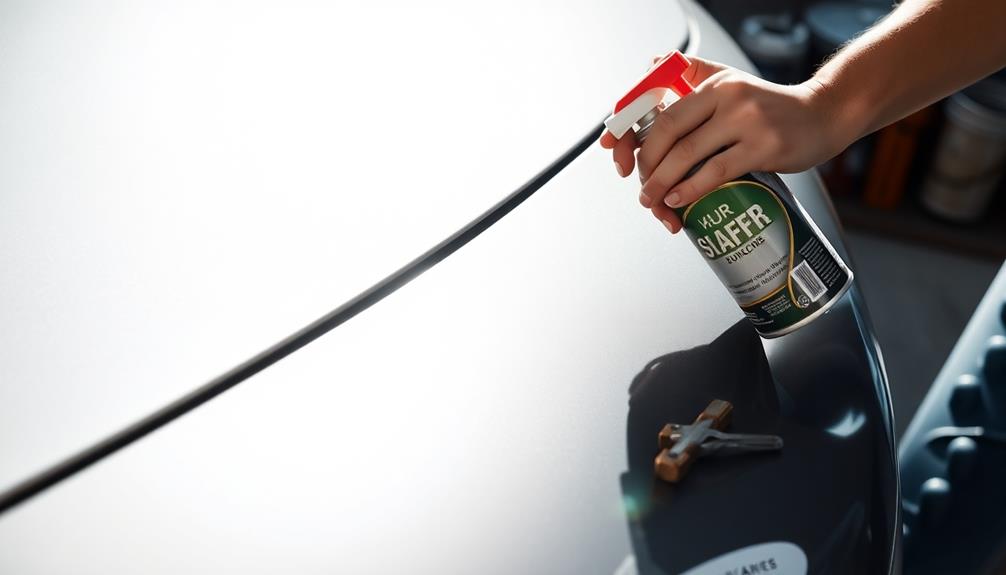
To guarantee your rust proofing is effective, choosing the right products is key.
Pay attention to application techniques and focus on vulnerable areas for the best results.
Choosing Right Products
Selecting the right rust-proofing products is essential for maintaining your vehicle's longevity. Focus on rust inhibitors specifically designed for automotive use, such as oil-based sprays that can penetrate deep into seams and crevices. These products create a protective barrier against corrosion, which is crucial if you live in an area where road salt is prevalent.
Additionally, ensuring proper application and maintenance of these products can further enhance their effectiveness and longevity, much like the care required for safe wood stove operation, including compliance with safety regulations.
When choosing a rust-proofing solution, consider the environmental conditions your vehicle will face. In regions with heavy road salt, look for products like Krown or Rust Check, known for their effectiveness in harsh winter climates.
You'll want a product that's easy to apply; spray-on options with directional nozzles can help you reach those tricky areas without making a mess.
Don't forget to check for any pre-application cleaning requirements. Applying rust-proofing agents on a dirty surface can greatly reduce adhesion and effectiveness.
Application Techniques
Once you've chosen the right rust-proofing product, it's time to focus on how to apply it effectively for the best results. Start at the front of your vehicle and work your way to the back, guaranteeing even coverage on seams and lower body panels.
Using an oil/wax hybrid coating enhances penetration, and warming the product slightly can improve flow and adhesion. To reach tight spaces, utilize cavity wands or directional nozzles. This is especially important for vulnerable areas like the rocker panels and fender openings.
Before application, inspect and clean any debris from these areas to prevent trapping moisture, which can promote rust. When applying the rust-proofing, make sure to direct the spray towards the drain holes to allow for proper drainage and prevent buildup.
Always follow the manufacturer's guidelines regarding drying times and reapplication frequency to guarantee your treatment lasts. By paying attention to these application techniques, you'll maximize the effectiveness of your rust-proofing efforts, keeping your car protected for years to come.
Regular Maintenance Practices
Your vehicle's longevity greatly depends on regular maintenance practices that help prevent rust from taking hold. Start by regularly inspecting your car for early signs of rust, especially in vulnerable areas like fender openings and rocker panels. Catching these issues early can save you from costly repairs down the line.
I highly recommend cleaning the underbody of your vehicle at least once a year, particularly after winter. This removes salt and debris that can accelerate rust formation.
Additionally, reapply rust-proofing treatments, such as oil or wax sprays, on an annual basis or according to product guidelines to guarantee effective protection. For best results, consider using a high-quality rust inhibitor like Krown, which you'll need to reapply approximately every 14 months.
Lastly, maintain thorough documentation of your rust-proofing efforts and inspections. This not only keeps you organized but can also enhance your vehicle's resale value by demonstrating proactive care.
Following these regular maintenance practices will help keep your car in excellent condition and free from the damaging effects of rust.
Frequently Asked Questions
What Is the Best Way to Rust Proof a Car?
To rust proof your car effectively, use a high-quality oil-based rust inhibitor. Apply it soon after purchase, targeting seams and lower panels. Reapply every 14 months for lasting protection, especially in winter conditions.
Is Rust Proofing Your Car Worth It?
You might think rust is just a stylish car accessory, but it's not. Rust proofing your car's definitely worth it; it protects your investment, prevents costly repairs, and keeps your ride looking sharp for years.
Does Vaseline Stop Rust on a Car?
Yes, Vaseline can help stop rust on your car by creating a temporary barrier against moisture. However, it's best for small areas and needs regular reapplication, as it doesn't offer long-term protection like specialized products.
What Are the Top 10 Rust Proof Cars?
When considering rust-proof cars, you'll find models like the Honda Accord, Toyota Camry, Subaru Outback, and Ford F-150 stand out. Their materials and designs effectively combat rust, making them reliable choices for durability and longevity.
Conclusion
By rust-proofing your car for just $10, you're not only saving money but also extending its lifespan. Did you know that nearly 75% of vehicles suffer from rust damage over time? Taking action now can keep your ride looking great and running smoothly for years to come. Remember, regular maintenance and reapplication are key to protecting your investment. So, grab your supplies and get started—you'll be glad you did!
